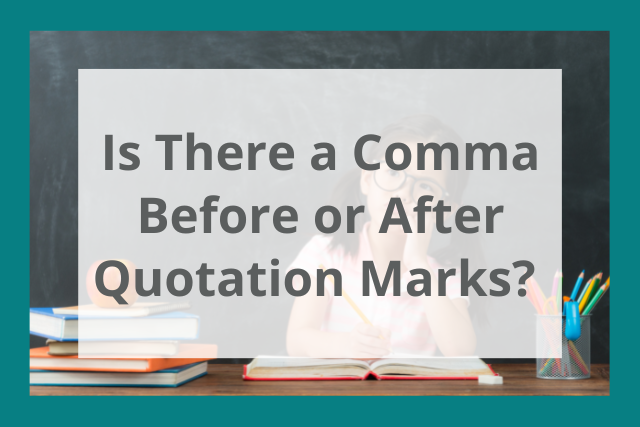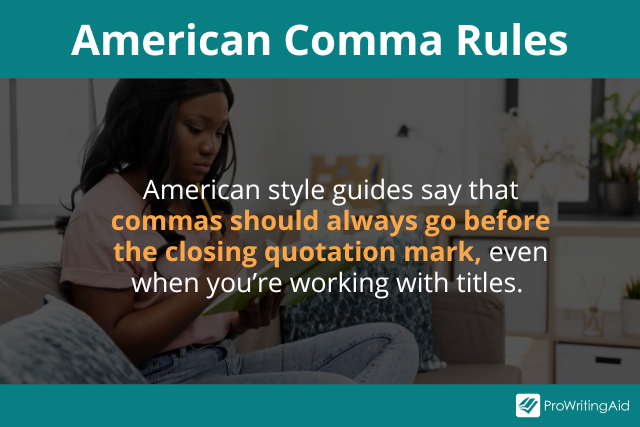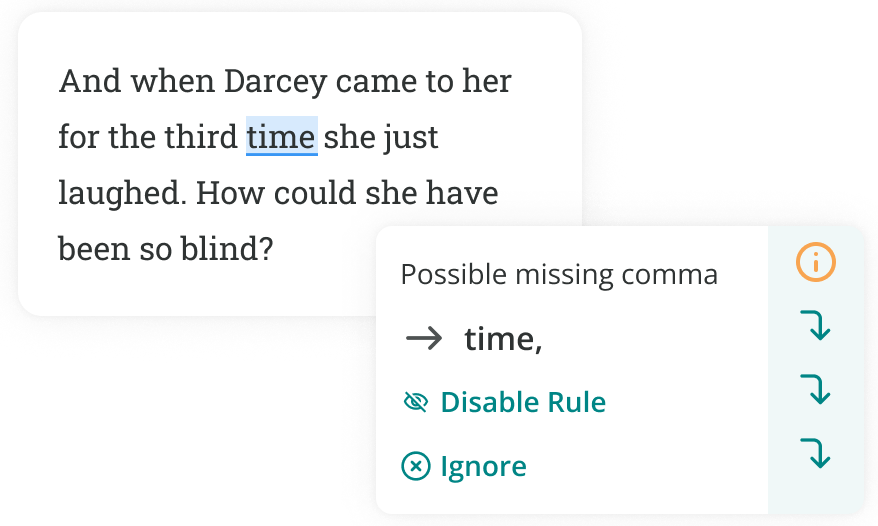
Many people get confused about how to punctuate quotation marks. If you’re wondering where to put a comma, you’re not alone.
So, should you use a comma before or after quotation marks?
The short answer is that you should place punctuation marks like commas and periods inside the quotation marks if you’re writing for an American audience. If you’re writing in British English, you can choose where the comma goes.
Learn more about where to place a comma in quotation marks and how to punctuate your work correctly.
Does the Comma Go Before or After the Closing Quotation Mark?
In American English, you should always place a comma or period inside the quotation marks. That means the comma should always come right before the closing quotation mark, even if it’s not part of the quoted material.
For example, you would write:
“I’m going to the store,” said my sister.
In British English, you can choose where the comma goes. British style guides allow commas after quotation marks. It’s acceptable to write:
“I’m going to the store”, said my sister.
The same rules apply to both double quotation marks and single quotation marks.
Most style guides, such as the Modern Language Association (MLA), Associated Press (AP), and The Chicago Manual of Style (Chicago) suggest the American rule.
If you're uncertain who your audience will be, then a good general rule is to always place your commas inside of quotes. That way, you'll never appear incorrect.
![American vs British comma rules]](https://marketing.prowritingaid.com/american-vs-british-comma-rules.png)
Where Should You Put Commas for Dialogue in Fiction?
All the rules above apply to punctuating dialogue in fiction. American grammar states that you should place the comma before the closing quotation mark, while the British rule allows you to put the comma after the closing quotation mark.
With dialogue, you’ll often want to follow a quote with a dialogue tag. In this case, according to American style guides, you should use a comma before the closing quotation mark. For example, you might write:
- “Go away,” the boy whispered softly.
You should also use a comma after a speaker tag to introduce quoted material when the speaker tag comes first. For example:
- The boy whispered softly, “Go away.”
Where Should You Put Commas for Quoted Titles?
You need to use quotation marks for the titles of articles, short stories, poems, and other similar forms of media.

American style guides say that commas should always go before the closing quotation mark, even when you’re working with titles. For example:
- My favorite Beatles songs are “Hey Jude,” “Get Back,” and “In My Life.”
Where Should You Put Commas for Quotes in Academic Writing?
With academic writing, it’s especially important to follow the style guide chosen by your institution. Because most academic institutions follow a style guide like Chicago Style or AP Style, it’s most common to follow American style.
The only exception is when you follow a quote with parentheses, such as when you add a citation. In this scenario, you should place the comma after the parenthetical rather than before the closing quotation mark.
For example:
- Smith writes that the president did “everything he could to ameliorate a tough situation” (Smith 24), justifying the president’s actions.
Where Should You Put Commas for Block Quotations?
If you’re quoting a long passage of text that occupies more than four lines on the page, you’ll need to use a block quotation instead of a normal quotation.
With block quotations, you don’t need to use quotation marks at all—just make sure you end the quoted text in a complete sentence and punctuate it accordingly. For example:
The block format is a freestanding quote that does not include quotation marks. Introduce the block quote with a colon (unless the context of your quote requires different punctuation) and start it on a new line. Indent the entire quote one inch from the left margin and double-space it (even if the rest of your paper is not double-spaced).—MLA Handbook, eighth edition
Examples of Correct Comma Placement in Double Quotation Marks
Let’s look at some examples of how to place a comma correctly.
Here’s an example of how to punctuate a comma with a dialogue tag:
- Correct: “I’ll come along later,” said Mary.
- Incorrect in US: “I’ll come along later”, said Mary.
- Incorrect: “I’ll come along later” said Mary.
Here’s an example of how to punctuate a comma after a subordinate clause:
- Correct: After I read Edgar Allan Poe’s poem “The Raven,” my respect for birds grew.
- Incorrect in US: After I read Edgar Allan Poe’s poem “The Raven”, my respect for birds grew.
- Incorrect: After I read Edgar Allan Poe’s poem “The Raven” my respect for birds grew.
Here’s an example of how to punctuate commas after quoted titles:
- Correct: Some of my favorite Taylor Swift songs are “Love Story,” “Red,” and “Anti-Hero.”
- Incorrect in US: Some of my favorite Taylor Swift songs are “Love Story”, “Red”, and “Anti-Hero.”
- Incorrect: Some of my favorite Taylor Swift songs are “Love Story” “Red” and “Anti-Hero.”
Finally, here’s an example of how to punctuate a comma in a compound sentence:
- Correct: My mother always told me “Don’t judge a book by its cover,” so I try not to jump to conclusions.
- Incorrect in US: My mother always told me “Don’t judge a book by its cover”, so I try not to jump to conclusions.
- Incorrect: My mother always told me “Don’t judge a book by its cover” so I try not to jump to conclusions.
Examples of Commas With Quotation Marks From Literature
The best way to learn grammar and punctuation is by seeing examples in the real world. Here are some quotations from English books that use commas correctly.
“Honestly,” he would tell them, sour-faced, “it’s not really worth anything at all. I’ll give you what I can, though, as it has sentimental value.”—Neil Gaiman, The Graveyard Book
“Great,” I said, “thank you,” but when I got off the phone, I felt sick—like someone had just reached a hand in my chest and wrenched loose a lot of ugly wet stuff around my heart.—Donna Tartt, The Goldfinch
“I’ve never seen eyes with your shade of blue,” Jimmy said, looking directly into her eyes. “It’s like the sea, but through a layer of ice.”—Ken Liu, The Paper Menagerie and Other Stories
“The Villa Straylight,” said a jeweled thing on the pedestal, in a voice like music, “is a body grown in upon itself, a Gothic folly.”—William Gibson, Neuromancer
It’s not that we hadn’t enough to eat at home, it’s just that my grandmother always cooked economy joints and economy meat loafs and had the habit of saying, the minute you lifted the first forkful to your mouth, “I hope you enjoy that, it cost forty-one cents a pound,” which always made me feel I was somehow eating pennies instead of Sunday roast.—Sylvia Plath, The Bell Jar
“Ethics” meant the golden rule, which was basically an aesthetic rule. That’s why it was called “golden,” like the golden ratio.—Elif Batuman, The Idiot
They say, “I’m fine. I’m okay, really,” and they really mean, I’m not unrecognizable to myself.—Jane Smiley, A Thousand Acres
A lesser creature would have answered “Certain,” or “Absolutely,” but nothing is more absolute than Jehovah Mason’s “Yes.”—Ada Palmer, Seven Surrenders
She began to laugh—a high-pitched old woman’s laugh. “April Fool’s Day,” she tittered.—Raymond Chandler, Farewell, My Lovely
“I love you,” says her mother, but there is a stiffness to it. They are not the kind of family who says it out loud.—Karen Thompson Walker, The Dreamers
They went off then, Rike doing that laugh of his, “hur, hur, hur,” as if he was trying to cough a fishbone out.—Mark Lawrence, Prince of Thorns
Conclusion on Where to Place Commas in Quotations
There you have it—a complete guide to using commas correctly with quotation marks. Here’s a quick recap:
- According to American style guides, you should always put a comma before the closing quotation mark
- If you’re following British style guides, you can choose where to put the comma

If you’re not sure you’re putting your commas in the right place, you can always run your work through ProWritingAid, which will highlight incorrect punctuation marks and help you fix them with one click.

